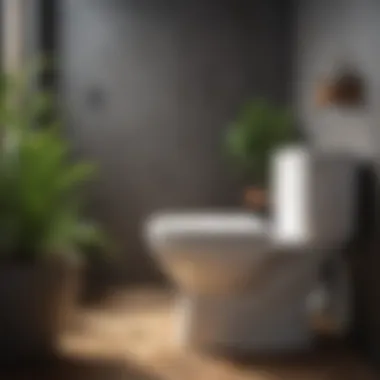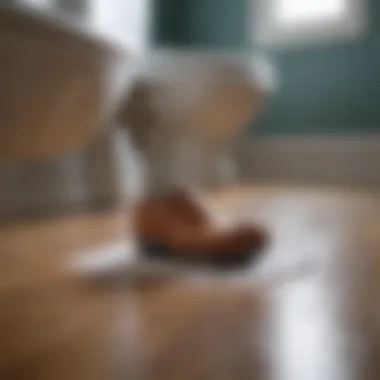Effective Clogged Toilet Solutions Without a Plunger


Intro
A clogged toilet can cause a lot of frustration. This problem is common but often occurs at the most inconvenient moments. Instead of grabbing a plunger, there are other methods that can prove effective in resolving the blockage. This article delves into alternative solutions that help clear a clogged toilet without the use of a plunger.
Whether it’s a minor blockage or a more serious issue, the strategies outlined here can make a difference. Homeowners can choose from natural remedies, mechanical aids, and various household items to tackle this challenge. Knowing these methods can keep the bathroom functional and avoid further complications.
Understanding Clogged Toilets
Understanding clogged toilets is essential for every homeowner. Not only is it a frequent issue, but it also disrupts daily activities. Clogged toilets can often lead to a more significant problem if not addressed promptly. This article focuses on alternative methods for resolving clogs without using a plunger. By gaining insight into how toilets become clogged, homeowners can be better prepared to tackle these challenges.
The first step to solving the problem is understanding its origins. Most clogs are not random occurrences but stem from certain behaviors or materials introduced into the toilet. Moreover, awareness of the signs can lead to early detection, minimizing damage and restoring functionality more quickly.
A well-informed homeowner can adopt preventive measures that greatly reduce the chances of experiencing a clogged toilet. This knowledge serves as a basis for effective management and reinforces the importance of routine checks and maintenance. Engaging with this topic can promote a smoother household experience and save both time and distress when trouble arises.
Common Causes of Clogs
Clogs can occur due to various factors. Here are some common causes that might be present in your household:
- Excessive toilet paper: Many people underestimate the amount of toilet paper they use. Thick layers can easily cause blockages.
- Non-flushables: Items like wet wipes, cotton balls, or feminine products should never be flushed. They do not break down like toilet paper.
- Foreign objects: Occasionally, children might flush toys or other objects. These items can create an immediate obstruction.
- Flushing too quickly: Rapid flushing can create water turbulence that displaces objects, leading to potential clogs.
By recognizing these factors, homeowners can make informed decisions regarding their toilet usage practices.
Signs of a Clogged Toilet
Being able to identify the signs of a clogged toilet is paramount. Here are some warning signs that you may encounter:
- Slow drainage: Water may take longer than usual to drain after flushing. This can indicate a blockage forming.
- Unusual sounds: Gurgling noises from the toilet bowl can signal air trapped in the plumbing due to clogging.
- Water backup: If water rises in the bowl after flushing, it typically means drainage issues.
- Odors: Foul smells near the toilet can suggest waste is not moving through the pipes adequately.
Paying attention to these signs can initiate preventive action and potentially save you from major plumbing issues in the future. Understanding clogged toilets in this manner enhances your ability to manage plumbing challenges efficiently.
Preventive Measures
Clogged toilets can be a source of frustration and disruption in any household. To minimize such occurrences, adopting proper preventive measures is crucial. Regular attention to maintenance can significantly increase the lifespan of your plumbing systems and ensure smoother operations. These practices not only save you from inconvenient crises but also reduce the overall repair costs associated with severe clogs.
Regularly maintaining your toilet involves simple yet effective habits that can prevent buildup over time. Furthermore, educating all members of the household about proper toilet usage can sustain these maintenance efforts. It is essential to be proactive rather than reactive in managing potential plumbing issues.
Regular Maintenance Habits
Implementing regular maintenance habits can effectively decrease the likelihood of clogs. Here are some key practices to consider:
- Routine Inspections: Check the toilet for leaks or irregularities at least twice a year. Pay attention to the flushing mechanism and tank components.
- Clean the Toilet Regularly: Use safe cleaning products to maintain hygiene. Unclogging chemicals may weaken the material over time. Gentle cleaning solutions are often the best choice.
- Clear the Drain: Occasionally lift the toilet seat and check for items that may have fallen in, such as sanitary products or plastic wrappers. Removing these items can prevent blockages.
- Monitor Water Levels: Ensure that the water is at the correct level in the tank. Too low can affect flushing power, while too high may lead to overflow issues.
- Check for Slow Drains: If water drains slowly, investigate the cause, as this may lead to future clogs.
By incorporating these maintenance habits, you can keep your toilet functioning optimally. Regular attention helps avert serious plumbing issues, serving to maintain both hygiene and functionality.


Educating Household Members
Teaching household members about proper toilet etiquette is just as important as regular maintenance. Everyone in the household should be informed about what can and cannot be flushed. Here are some essential points to communicate:
- Understand What Goes In: Emphasize that the toilet is designed to handle only human waste and toilet paper. Other items should be disposed of in the trash.
- Frequency of Use: Encourage everyone to be mindful of their usage. Avoid excessive flushing in a short amount of time, as this could strain the system.
- Avoid Chemical Use: Alert others not to use harsh chemicals for minor cleaning tasks. These can corrode pipes over time, leading to clogs.
- Report Issues Promptly: Urge family members to inform you of any unusual sounds or slow drains promptly. Early detection is key to preventing larger problems.
Educated household members can play a vital role in maintaining toilet function and preventing clogs.
By fostering awareness and responsible usage, you create a team approach toward toilet maintenance. As a result, these preventive measures can reduce inconvenience and enhance the efficiency of bathroom facilities.
Natural Solutions
Natural solutions for clogged toilets are beneficial for numerous reasons. They provide effective alternatives to chemical treatments, minimizing harm to both plumbing systems and the environment. Using readily available household items, these methods offer cost-effective remedies that are easy to implement. Moreover, they reduce dependency on harsh chemicals that can potentially damage pipes and lead to environmental pollution. By exploring these natural methods, homeowners can maintain their plumbing system in a safe and eco-friendly manner.
Baking Soda and Vinegar Method
The baking soda and vinegar method is a popular choice for addressing minor clogs. The combination of these two substances creates a chemical reaction that can help break down waste and debris. To use this method, follow these steps:
- Remove Excess Water: Begin by removing excess water from the toilet bowl, as this will allow the substances to work more effectively.
- Add Baking Soda: Pour about one cup of baking soda into the toilet bowl. This will help to neutralize odors and may begin the breakdown of waste.
- Add Vinegar: Next, pour about two cups of vinegar into the bowl. You will see bubbles and fizzing occur. This reaction is crucial for helping to dislodge the clog.
- Wait: Allow the mixture to sit for at least 30 minutes. For tougher clogs, waiting for several hours or overnight may yield better results.
- Flush: Finally, after the waiting period, flush the toilet to check if the clog has cleared. If it has not, repeating the method may be necessary.
This method is safe for most plumbing systems and is an effective first step in tackling a clogged toilet.
Hot Water Technique
The hot water technique is another effective solution that utilizes the physical properties of heat to dissolve clogs. Hot water can help break down material that may be causing the blockage. However, caution must be exercised, especially with older plumbing systems, as boiling water can crack porcelain toilets.
To execute this method, follow these steps:
- Heat Water: Begin by boiling a kettle of water. Avoid using water that is boiling, as this could damage your toilet.
- Disperse Hot Water: Once the water has heated, carefully pour it into the toilet from waist height. Pouring from this height enhances the impact of the water, allowing it to reach deeper areas of the plumbing.
- Wait and Observe: After pouring the hot water, wait for a few minutes to see if the water begins to drain. This indicates that the clog is dissolving.
- Flush the Toilet: Once this step is complete, attempt to flush the toilet. If the water drains properly, the issue may be resolved. If not, additional methods may be required.
Using hot water can be a convenient way to manage minor clogs, and it is especially effective in conjunction with other methods such as baking soda and vinegar.
Mechanical Approaches
Mechanical solutions present concrete options for addressing toilet clogs effectively. These methods have the advantage of not relying on chemical agents, which can be harsh and potentially damaging to plumbing systems. Utilizing physical tools can assist in clearing blockages quickly and often with less risk of injury to fixtures.
Using a Toilet Auger
Toilet augers are specially designed tools that navigate the curves and bends of a toilet's plumbing system. This makes them ideal for dislodging stubborn clogs. A typical auger consists of a long, flexible steel cable with a coiled end that breaks up or retrieves obstructions.
Steps to Use a Toilet Auger:
- Prepare the Area: Remove any items around the toilet. Put on gloves and ensure good ventilation.
- Insert the Auger: Feed the auger into the toilet bowl. Push it gently until you meet resistance, which indicates a blockage.
- Crank the Handle: Turn the handle slowly to break up the clog. This motion allows the coiled end to latch onto the obstruction or grind it down.
- Retract the Auger: Once you feel the clog give way, carefully pull the auger back out. It may bring debris with it, which can help in assessing the clog's nature.
- Flush the Toilet: After successful clearing, flush to ensure the blockage is fully removed and the line is clear.
Using a toilet auger effectively can save time and prevent additional plumbing issues.


Employing a Wet/Dry Vacuum
A wet/dry vacuum serves as an excellent tool for removing clogs without fuss. This method harnesses suction power to pull out blockages that a plunger cannot dislodge. With the right technique, a wet/dry vacuum can clear smaller clogs both in the toilet and the pipes connected to it.
How to Use a Wet/Dry Vacuum:
- Set Up the Vacuum: Make sure the vacuum is suitable for wet use. Remove any filters that could be damaged by water.
- Create a Seal: If possible, create a seal at the toilet rim to maximize suction. You can do this with a towel or rag.
- Insert the Hose: Place the vacuum hose into the toilet bowl. This step should be done carefully to avoid splashes.
- Turn on the Vacuum: Activate the vacuum to suck out the clog. Keep the hose in place until you feel confident the blockage is cleared.
- Check the Results: After vacuuming, check the toilet's performance by flushing it to observe if the water flows correctly.
Both methods, the toilet auger and wet/dry vacuum, offer reliable mechanical approaches to unclogging toilets. Adopting these techniques can improve the functionality of your bathroom and gradually reduce dependency on chemical solutions, which may not always be favorable.
Chemical Solutions
Chemical solutions play a significant role in addressing clogged toilets, particularly when other methods have not yielded success. These products are specifically formulated to break down organic material and paper, which are common culprits behind blockages. Utilizing chemical solutions can save time and effort, providing a more immediate remedy for stubborn clogs. However, it is crucial to understand both the advantages and possible drawbacks associated with these chemicals.
Using chemical solutions can be beneficial in many scenarios. They often require less manual effort compared to physical methods. Moreover, they can penetrate deep into the plumbing systems, reaching areas that might not be effectively accessed by mechanical tools. Nevertheless, this method does carry certain considerations that users should keep in mind to ensure safety and efficacy.
Commercial Drain Cleaners
Commercial drain cleaners are readily available in most households and can be a quick solution to a clogged toilet. These products often contain active ingredients that dissolve or dislodge blockages. Common ingredients include sodium hydroxide and sulfuric acid, which effectively break down organic materials.
When using these cleaners, read the instructions carefully. Here are some key points to consider:
- Effectiveness: Some brands may work better for specific types of clogs than others.
- Speed: Many drain cleaners act within minutes, making them a quick choice for urgent situations.
- Types: Liquid, crystal, and gel formulations are examples of different types available. Each serves a particular purpose and may vary in effectiveness.
- Limitations: It is important to note that not all drain cleaners are safe for toilets, especially those made of particular materials.
"Before applying any commercial drain cleaner, assess the nature of the clog first, as different products work best under certain circumstances."
Safety Precautions
While chemical solutions are effective, they also present certain risks. Understanding safety precautions is crucial to minimize danger to oneself and potential harm to plumbing.
Here are essential safety precautions to undertake:
- Ventilation: Always ensure proper ventilation in the bathroom. Fumes from drain cleaners can be toxic.
- Protective Gear: Wear gloves and goggles to protect skin and eyes from splashes.
- Avoid Mixing: Never mix different cleaning chemicals. The reaction could create harmful gases.
- Follow Instructions: Adhere strictly to the manufacturer's instructions to prevent adverse reactions.
- Flush Carefully: After the chemical has had time to work, flush the toilet thoroughly. This helps to clear out any remaining residue that could be harmful.
Using chemical solutions responsibly can lead to effective and practical resolution of toilet clogs. Knowledge of the products available and careful adherence to safety protocols can enhance the experience significantly.
Long-term Solutions
Addressing clogged toilets is often seen as an immediate concern, but considering long-term solutions can significantly improve the overall plumbing situation in your home. These solutions aim to not just fix a problem as it arises, but to tackle underlying issues that could lead to recurring clogs. By implementing these strategies, homeowners can reduce the frequency of blockages and maintain a smoother functioning bathroom. This could involve identifying the root causes of clogs and making necessary upgrades to the plumbing system.
Identifying the Root Cause
Understanding the root cause of clogs is essential for preventing future issues. Frequent blockages may arise from various factors, including:
- Tree Roots: In some cases, roots from nearby trees can infiltrate sewer pipes.
- Pipe Deterioration: Older pipes may corrode or crack, causing debris to accumulate.
- Improper Disposal: Flushing inappropriate items can lead to persistent clogs.


A thorough inspection can help identify specific problems in your plumbing. Video camera inspections can reveal hidden issues within pipes, allowing for targeted repairs rather than treating symptoms.
Utilizing professional services can guide you through this process and provide valuable insights.
Considerations for System Upgrades
When considering upgrades, it is vital to assess the existing plumbing infrastructure. Several factors warrant attention, such as:
- Pipe Material: Old pipes, especially those made of cast iron or clay, may need replacing with more durable options like PVC or ABS. These materials are less likely to rust or corrode.
- Drainage Slope: Ensuring that pipes have an appropriate slope can prevent stagnation and encourage proper flow.
- Toilet Design: Upgrading to a high-efficiency toilet can minimize clogs. These toilets use water more effectively and reduce waste buildup.
Implementing these long-term solutions can lead to significant cost savings on frequent repairs or plumbing services.
"Investing in long-term solutions is more effective than temporarily fixing problems as they arise."
Homeowners should weigh the benefits of these upgrades against the potential costs. An informed decision will result in a more reliable and efficient plumbing system.
When to Call a Professional
Experiencing a clogged toilet can vary in severity, and understanding when to seek professional help is essential. Some clogs can be resolved through do-it-yourself methods, but others require expert intervention. Relying on professional services can save time and prevent potential damage. This section discusses specific indicators that signify the need for professional plumbing assistance, along with tips for finding reliable services.
Indicators of Severe Clogs
While minor clogs might clear up with simple techniques, several signs indicate a more significant problem. Here are key indicators that suggest a bad clog:
- Persistent Backups: If water repeatedly rises in the bowl and toilet doesn’t flush, it may signal issues in the drainage system.
- Multiple Fixtures Affected: If other drains in the house are also slow or backing up, this suggests a more extensive blockage in the plumbing lines.
- Unpleasant Odors: Lingering sewage odors could indicate a clog that needs immediate attention, as these can lead to more significant sanitary and health issues.
- Drainage Gurgles: Gurgling sounds during flushing or when using other sinks may mean that air is trapped in the pipes, often linked to a blockage.
Acting promptly when encountering these signs is crucial to avoid more serious complications, such as pipe damage or overflow.
Finding Reliable Plumbing Services
When the decision is made to consult a professional plumber, knowing how to find the right one is important. Here are steps to ensure you select reliable plumbing services:
- Research and Reviews: Check online platforms for reviews. Websites like reddit.com and angie's list can provide insights into customer experiences.
- Get Recommendations: Ask friends, family, or neighbors for suggestions. Referrals from trusted people are often worth their weight in gold.
- Verify Credentials: Ensure the plumber has the necessary licenses and insurance. This protects you from liability and ensures their work meets legal standards.
- Obtain Estimates: Before work begins, ask for a detailed estimate. This should outline potential costs in case of further complications.
- Check Experience: Inquire about the plumber's experience with specific issues you have. Knowledge in residential plumbing ensures better solutions.
Keeping the above points in mind can help you make an informed decision when transitioning from a DIY approach to hiring a professional. This ensures any clogged toilet issues are dealt with correctly and efficiently.
The End
Addressing a clogged toilet promptly is essential to maintaining a functional household. A malfunctioning toilet can disrupt daily routines and lead to more significant plumbing issues. In this article, we have explored various effective methods to resolve clogs without using a plunger. Understanding these solutions equips homeowners with the knowledge to tackle different types of blockages efficiently.
Recap of Solutions
Each approach discussed presents unique benefits:
- Natural Solutions: Utilizing common household items like baking soda and vinegar can provide an eco-friendly method to clear minor clogs.
- Mechanical Approaches: Tools like a toilet auger or a wet/dry vacuum offer powerful alternatives for stubborn blockages.
- Chemical Solutions: While commercial drain cleaners are effective, one must consider safety precautions to avoid harmful chemicals.
- Long-term Solutions: Identifying the root causes of recurring clogs can help prevent future issues, while upgrades to plumbing systems may be a necessary investment.
- Professional Help: Knowing when to call a professional is crucial to avoid exacerbating the problem.
"A proactive approach can often save time, expense, and stress in the long run."
Encouragement for Proactive Measures
Prevention is always better than cure. By adopting regular maintenance habits, such as ensuring that only appropriate materials enter the toilet, homeowners can significantly reduce the likelihood of experiencing clogs.
Educating household members about what can and cannot be flushed is also vital. Simple measures like installing a waste basket for disposal of non-flushable items can prevent many problems before they arise.







